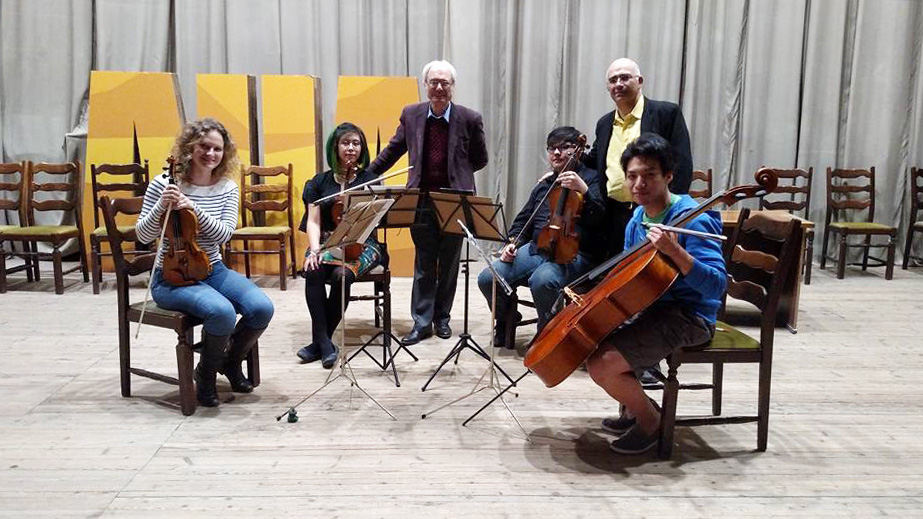UCLA music students perform Armenian pieces in Yerevan, lauded by natives

UCLA graduate musicians performed a piece by Tigran Mansurian (middle), an Armenian classical composer, on a trip to Armenia. They performed for audiences at the Komitas Museum and Komitas Chamber Music Hall in the capital city of Yerevan. (Courtesy of Movses Pogossian)
By Kyle Young
April 6, 2016 12:44 a.m.
The audience paused for a brief moment before rising to its feet in a standing ovation for the musicians of VEM Quartet and their mezzo-soprano, Danielle Bayne. Just days before, members of the group, none of whom are ethnically Armenian, were feeling the immense pressure of performing Armenian classical music in its native homeland.
Bayne, along with the members of the UCLA graduate string quartet-in-residence, were invited to the country as part of the Armenian Music Program. Funded by anonymous donors, the program provided the master’s students with scholarships in return for their in-depth study and outreach performance of Armenian music. Their performances in Yerevan, the capital of Armenia, were an integral part of a workshop “The Interface between Music and Nationalism,” an event organized by the University of California-founded school, the American University of Armenia.
The storied music of Armenian composers Komitas, Tigran Mansurian, Tchichyan and Alan Hovhaness flowed across the hotel courtyard as the group spent days rehearsing for their performances Friday and Saturday at the Komitas Museum and Komitas Chamber Music Hall.
Bayne, a graduate student in vocal performance and opera, said representing Armenian classical music in its birthplace presented something of a cross-cultural challenge. Although she does not speak the native language, conveying universal emotions in a genuine, heartfelt and authentic way was the highest priority for Bayne and took weeks of work.
“It’s beautiful; there’s a certain passion and sadness in the music,” Bayne said.
Bayne worked closely with Movses Pogossian, a professor of violin at the Herb Alpert School of Music and Vatsche Barsoumian, director of the Lark Musical Society, to interpret many of the pieces she would be performing.
Barsoumian, who trained in conducting with a concentration in voice, said he spent painstaking hours with Bayne on the transliteration from Armenian to English, translating each piece word for word and explaining every idiomatic derivation.
While in Armenia, Pogossian and the group also met with UCLA Armenian studies professor Peter Cowe, who was in the country hosting the workshop. Cowe took the group to explore historically significant sights in an effort to help the performers get a more well-rounded feel for the Armenian culture they would be expressing on the stage.
On the day of their last performance, the group paid a visit to the Armenian Genocide Memorial atop a grassy hill overlooking Yerevan. “Spring,” a plaintive and simple piece by composer Komitas, played over loudspeakers as visitors laid flowers next to a flame in the center of the memorial.
“Spring,” a piece that Bayne and the VEM Quartet performed later on that weekend, reflected on the collective struggles of the Armenian people in the early 20th century, as they were massacred and exiled from their homeland.
Bayne said visiting the site, which was still commemorating the 100 year anniversary of the Armenian Genocide last year, illustrated to the entire group the profound importance of music in uniting the country.
After visiting the memorial, Bayne was able to tap into the deeper, more solemn emotions of heartache and longing that helped translate to the authenticity of the performance. She said that being able to sing and represent pieces by Komitas and Mansurian was an opportunity to convey to the Armenian people a deep respect and appreciation for their culture.
“Being able to bring that heaviness and sincerity after having seen that memorial made the performance that much more powerful,” Bayne said, “not just to (the audience) but for me as well.”
Pogossian, who has played violin music at the Komitas Chamber Music Hall multiple times since the age of 13, understood the pressure that the group was facing. He said he feared that the students’ performance would be met by discriminate opinion, as classical music is very important to the people of Yerevan.
“When one finds true, pure Armenian melody, it is often very sincere and poetic … (as such), expectations were extremely high,” Pogossian said.
Although he initially felt a sense of tension, his apprehension quickly turned into pride. Pogossian found it especially heartening to see the audience erupt into applause after the performance, which he said validated all the time Bayne and the Quartet spent researching and practicing.
Some audience members, so impressed with Bayne’s pronunciation of the native language, later jokingly offered to grant her dual Armenian citizenship.
“It’s amazing how welcome and accepting (the audience was) of the music,” Bayne said. “Seeing people like us who are not Armenian coming and performing Armenian music, it’s really special to them. It was wonderful to be a part of that.”


